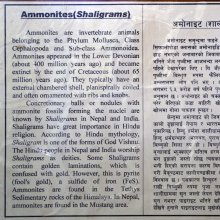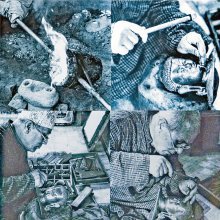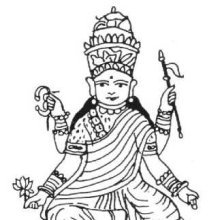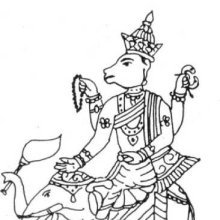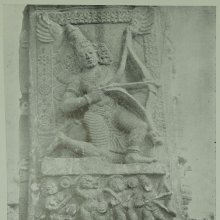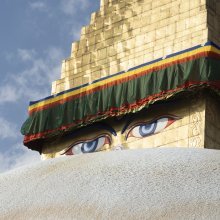Gold, Golden: 5 definitions
Introduction:
Gold means something in Hinduism, Sanskrit, Jainism, Prakrit, the history of ancient India. If you want to know the exact meaning, history, etymology or English translation of this term then check out the descriptions on this page. Add your comment or reference to a book if you want to contribute to this summary article.
Images (photo gallery)
(+81 more images available)
In Hinduism
Natyashastra (theatrics and dramaturgy)
Source: Shodhganga: Elements of Art and Architecture in the Trtiyakhanda of the Visnudharmottarapurana (natya)Gold is associated with Catura-hasta: one of the twenty-two Single-hand Gestures (in Indian Dramas) (known as asaṃyuktahastas), according to the Viṣṇudharmottarapurāṇa, an ancient Sanskrit text which (being encyclopedic in nature) deals with a variety of cultural topics such as arts, architecture, music, grammar and astronomy.—According to the Viṣṇudharmottarapurāṇa, some colours are pointed with the catura hand gesture. [...] Instead of showing colours, in the Abhinayadarpaṇa, the caturahasta posture denotes some metals like gold, copper and iron. This posture also shows the application of some greasy substances like oil, ghee etc on the face

Natyashastra (नाट्यशास्त्र, nāṭyaśāstra) refers to both the ancient Indian tradition (shastra) of performing arts, (natya—theatrics, drama, dance, music), as well as the name of a Sanskrit work dealing with these subjects. It also teaches the rules for composing Dramatic plays (nataka), construction and performance of Theater, and Poetic works (kavya).
Shilpashastra (iconography)
Source: Shodhganga: Elements of Art and Architecture in the Trtiyakhanda of the Visnudharmottarapurana (shilpa)1) Gold is denoted by the Sanskrit term Kanaka and represents one of the materials used to make Colours in the ancient Indian tradition of Painting (citra), according to the Viṣṇudharmottarapurāṇa, an ancient Sanskrit text which (being encyclopedic in nature) deals with a variety of cultural topics such as arts, architecture, music, grammar and astronomy. In the Viṣṇudharmottarapurāṇa, various materials are seen to be used to make colours. e.g., Gold (kanaka). Also, five colours are regarded as the primary ones, (viz., white, yellow, colour of vilomata, black, dark blue.). A painter can create hundreds or thousands of colours by amalgamating the primary colours.
2) The Golden complexion is associated with Śakra (Indra) iconography.—According to the Viṣṇudharmottarapurāṇa, the image of Śakra or Indra should be golden in complexion and should wear blue garments. The statue of Śakra should be placed on an elephant which have four tusks. Thus it is clear that the Viṣṇudharmottarapurāṇa offers a great field of knowledge regarding the nuances of Indian art of Image making [e.g., the golden complexion of Indra] during 10th–11th century A.D.

Shilpashastra (शिल्पशास्त्र, śilpaśāstra) represents the ancient Indian science (shastra) of creative arts (shilpa) such as sculpture, iconography and painting. Closely related to Vastushastra (architecture), they often share the same literature.
Shaivism (Shaiva philosophy)
Source: Google books: Genesis and Development of TantraGold refers to one of the various objectives expected of the Vedic rituals (following the basic pattern of the new and full-moon sacrifice) known as the Kāmyeṣṭis.—to the analysis of W. Caland, the objectives expected of the kāmyeṣṭis are: [e.g., gold] [...], etc. (Cf. Caland 1908: VI–VII). Although Vedic rituals were a reliable way for the people of ancient India to fulfill their objectives, Tantric rites too claim to bring about the attainment of wishes.

Shaiva (शैव, śaiva) or Shaivism (śaivism) represents a tradition of Hinduism worshiping Shiva as the supreme being. Closely related to Shaktism, Shaiva literature includes a range of scriptures, including Tantras, while the root of this tradition may be traced back to the ancient Vedas.
In Jainism
General definition (in Jainism)
Source: The University of Sydney: A study of the Twelve ReflectionsGold is easy to find (as opposed to Wisdom), as discussed in Bhūdhardās’s composition dealing with the twelve reflections (bhāvanā or anuprekṣā), also found in the Tattvārtha-sūtra.—Accordingly, “[...] [eliminating karma]—Follow the five great vows as well as the five mindfulnesses. Conquer the five powerful sense-organs and establish yourself firmly in elimination. (10) [the world]—The Cosmic Man stands fourteen rājus tall. Within him countless souls wander without knowledge. (11) [wisdom is difficult to obtain]—Wealth, prosperity, gold, the pleasures of power—all these are easy to find. What is difficult to get in saṃsāra is the single knowledge that is appropriate. (12) [...]”.

Jainism is an Indian religion of Dharma whose doctrine revolves around harmlessness (ahimsa) towards every living being. The two major branches (Digambara and Svetambara) of Jainism stimulate self-control (or, shramana, ‘self-reliance’) and spiritual development through a path of peace for the soul to progess to the ultimate goal.
India history and geography
Source: Singhi Jain Series: Ratnaprabha-suri’s Kuvalayamala-katha (history)Gold (of highest purity) is mentioned in 8th century poems of ancient India, according to “A Cultural note on the Kuvalayamala of Uddyotanasuri” by the late Dr. V. s. Agrawala.—There is a reference to gold of highest purity (jacca-suvaṇṇa=jātya-suvarṇa). Whatever impurity or dross was contained in the gold brought to the goldsmith was removed by the latter by subjecting it to different processes of testing it on the touch-stone, cutting, heating under regulated fire, beating out into flat sheets, filing the sheets and the same process of beating it into a different shape, giving it a shape of round bar and dividing into several parts for final testing.

The history of India traces the identification of countries, villages, towns and other regions of India, as well as mythology, zoology, royal dynasties, rulers, tribes, local festivities and traditions and regional languages. Ancient India enjoyed religious freedom and encourages the path of Dharma, a concept common to Buddhism, Hinduism, and Jainism.
See also (Relevant definitions)
Starts with (+19): Garland of gold, Gold and silver flower, Gold cup silver plate, Gold flower, Gold kiwi, Gold mohur, Gold thread, Gold whisker, Gold-wire, Goldaar, Goldar, Goldaru, Golden alexander, Golden anise hyssop, Golden apple, Golden armour, Golden beard grass, Golden candelabra tree, Golden cassia, Golden chain tree.
Query error!
Full-text (+5652): Suvarna, Hema, Hiranya, Svarna, Kanaka, Kancana, Sauvarna, Tapaniya, Hataka, Jambunada, Haima, Camikara, Jatarupa, Hiranmaya, Kanakamaya, Nishka, Svarnaka, Hairanya, Rukma, Raukma.
Relevant text
Search found 523 books and stories containing Gold, Golden, The gold; (plurals include: Golds, Goldens, The golds). You can also click to the full overview containing English textual excerpts. Below are direct links for the most relevant articles:
Alchemy in India and China (by Vijaya Jayant Deshpande)
3. Case of an herb transmuting mercury and iron gold < [Chapter 7 - Indian and Chinese Alchemy—Parallels]
5. Case of purple gold < [Chapter 7 - Indian and Chinese Alchemy—Parallels]
1. Introduction (the history of Alchemy in India) < [Chapter 2 - Alchemy in India]
Matsya Purana (critical study) (by Kushal Kalita)
Part 5.1 - The sixteen Mahādānas < [Chapter 4 - Religious aspects of the Matsyapurāṇa]
Part 5.2 - The ten Merudānas < [Chapter 4 - Religious aspects of the Matsyapurāṇa]
Part 4.2c - Saṃkrānti-vrata < [Chapter 4 - Religious aspects of the Matsyapurāṇa]
Minerals and Metals in Sanskrit literature (by Sulekha Biswas)
4. Metals in the Mahabharata < [Chapter 6 - Minerals and Metals in the Indian Epics]
6. Ornaments and Gems in the Rigveda < [Chapter 2 - Minerals and Metals in the Rigveda]
6. Ornamental and Barter Metals < [Chapter 3 - Minerals and Metals in the Vedic literature after Rigveda]
Maha Prajnaparamita Sastra (by Gelongma Karma Migme Chödrön)
6. Birth and the thirty-two marks (lakṣaṇa) < [Part 4 - The Bodhisattva in the Abhidharma system]
Appendix 2 - The location of Suvarṇabhūmi or Suvarṇadvīpa < [Chapter XVI - The Story of Śāriputra]
Section A.1 - Rejecting colors < [Part 2 - Means of acquiring meditation]
Linga Purana (by J. L. Shastri)
Chapter 39 - The procedure for the gift of golden horse < [Section 2 - Pūrvabhāga]
Chapter 37 - The mode of gifting the golden cow along with gingelly seeds < [Section 2 - Pūrvabhāga]
Chapter 35 - The mode of gifting the golden cow < [Section 2 - Pūrvabhāga]
Related products
(+94 more products available)
